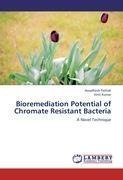
-
 Anglický jazyk
Anglický jazyk
Bioremediation Potential of Chromate Resistant Bacteria
Autor: Awadhesh Pathak
The conventional treatment methodology for soils and ground water systems contaminated with Cr (IV) is excavation (or) pumping of the contaminated material, addition of chemical reductant, precipitation followed by sedimentation, or ion exchange or adsorption.... Viac o knihe
Na objednávku
45.36 €
bežná cena: 50.40 €
O knihe
The conventional treatment methodology for soils and ground water systems contaminated with Cr (IV) is excavation (or) pumping of the contaminated material, addition of chemical reductant, precipitation followed by sedimentation, or ion exchange or adsorption. These physico-chemical methods suffer from high costs associated with energy and chemical consumption. The search for new and innovative technology for the remediation of Cr (VI) pollution has attracted the attention on the biotransformation potential of certain microorganisms. Microbial reduction of toxic hexavalent chromium to less soluble trivalent form as a normal function of their metabolism seems to be a potential method for the remediation of Cr (VI) contaminations. Many microbe have the potential to reduce the highly soluble and toxic Cr (VI) to the less soluble and less toxic Cr (VI) There are many examples where chromate-resistance is due to the presence of efflux mechanisms which allow resistant strains to extrude CrO4-2 ions. However, the availability of effective Cr (VI) -reducing organisms is an essential prerequisite for the bioreduction-based remediation of Cr (VI) - contaminated water/soil.
- Vydavateľstvo: LAP LAMBERT Academic Publishing
- Rok vydania: 2012
- Formát: Paperback
- Rozmer: 220 x 150 mm
- Jazyk: Anglický jazyk
- ISBN: 9783659276583












